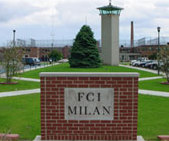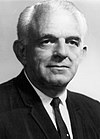


Seal of the Federal Bureau of Prisons
| |
| Agency overview | |
|---|---|
| Formed | May 14, 1930; 94 years ago (May 14, 1930) |
| Headquarters | Federal Home Loan Bank Board Building, Washington, D.C., U.S. |
| Motto | Courage. Respect. Integrity. Correctional Excellence. |
| Employees | 36,697[1] |
| Annual budget | US$9.3 billion (FY 2021)[2] |
| Agency executives |
|
| Parent agency | Department of Justice |
| Website | bop.gov |

The Federal Bureau of Prisons (BOP) is responsible for all Federal prisons and provide for the care, custody, and control of federal prisoners.
The federal prison system had existed for more than 30 years before the BOP was established. Although its wardens functioned almost autonomously, the Superintendent of Prisons, a Department of Justice official in Washington, was nominally in charge of federal prisons.[3] The passage of the "Three Prisons Act" in 1891 authorized the first three federal penitentiaries: USP Leavenworth, USP Atlanta, and USP McNeil Island with limited supervision by the Department of Justice.[4]
Until 1907, prison matters were handled by the Justice Department General Agent, with responsibility for Justice Department accounts, oversight of internal operations, certain criminal investigations as well as prison operations. In 1907, the General Agent was abolished, and its functions were distributed between three new offices: the Division of Accounts (which evolved into the Justice Management Division); the Office of the Chief Examiner (which evolved in 1908 into the Bureau of Investigation, and in the early 1920s into the Federal Bureau of Investigation); and the Office of the Superintendent of Prisons and Prisoners, later called the Superintendent of Prisons (which evolved in 1930 into the Bureau of Prisons).

The Bureau of Prisons was established within the Department of Justice on May 14, 1930 by the United States Congress,[5] and was charged with the "management and regulation of all Federal penal and correctional institutions."[6] This responsibility covered the administration of the 11 federal prisons in operation at the time. By the end of 1930, the system had expanded to 14 institutions with 13,000 inmates, and a decade later in 1940, the system had 24 institutions with 24,360 incarcerated.
The state of Alaska assumed jurisdiction over its corrections on January 3, 1959, using the Alaska Department of Corrections; prior to statehood, the BOP had correctional jurisdiction over Alaska.[7]
As a result of the Sentencing Reform Act of 1984 and subsequent legislation, which pushed for longer sentences, less judicial discretion, and harsher sentences for drug-related offenses, the federal inmate population doubled in the 1980s and again in the 1990s. The population increase decelerated in the early 2000s, but the population continued to increase until 2014.[8] [9]
The National Capital Revitalization and Self-Government Improvement Act of 1997 transferred responsibility for adult felons convicted of violating District of Columbia laws to the BOP.
The current director of the Bureau of Prisons is Colette S. Peters.[10][11]
As of 2020, 62.5% of Bureau employees are white, 21.3% are black, 12.6% are Hispanic, 2.3% are Asian, and 1.3% are Native American. 72% are male.[12] There is roughly one corrections officer for every 12.5 prisoners.[13]
All BOP law enforcement employees undergo 200 hours of formal training in their first year of employment and an additional 120 hours of training at the Federal Law Enforcement Training Centers (FLETC) in Glynco, Georgia.[14]
| Portrait[15] | Director | Took office | Left office |
|---|---|---|---|

|
Sanford Bates | 1930 | 1937 |

|
James V. Bennett | 1937 | 1964 |

|
Myrl E. Alexander | 1964 | 1970 |

|
Norman A. Carlson | 1970 | 1987 |

|
J. Michael Quinlan | July 1987 | 1992 |

|
Kathleen Hawk Sawyer | December 4, 1992 | April 4, 2003 |

|
Harley G. Lappin | April 4, 2003 | December 21, 2011 |

|
Charles E. Samuels Jr. | December 21, 2011 | January 9, 2016 |

|
Mark S. Inch | September 18, 2017 | May 18, 2018 |
| Hugh Hurwitz (acting) | May 2018 | August 19, 2019 | |

|
Kathleen Hawk Sawyer | August 19, 2019 | February 25, 2020 |

|
Michael D. Carvajal | February 25, 2020 | August 2, 2022 |

|
Colette S. Peters | August 2, 2022 | Present |

The BOP has five security levels:
Some units have small, adjacent, minimum-security "satellite camps". Twenty-eight institutions hold female inmates. As of 2010[update], about 15% of Bureau inmates are in facilities operated by third parties, mostly private companies, while others are in local and state facilities. Some are in privately operated Residential Reentry Centers (RRC) or Community Corrections Centers. The Bureau uses contract facilities to manage its own prison population because they are "especially useful" for housing low-security, specialized groups of people, such as sentenced criminal aliens.[17]
In the BOP, correctional officers are uniformed federal law enforcement officers who are responsible for the care, custody, and control of federal inmates. The BOP has a Special Operations Response Team and Disturbance Control Team.
| FY | Population | Change |
|---|---|---|
| 2000 | 145,125 | +11,436 |
| 2001 | 156,572 | +11,447 |
| 2002 | 163,436 | +6,864 |
| 2003 | 172,499 | +9,063 |
| 2004 | 179,895 | +7,396 |
| 2005 | 187,394 | +7,499 |
| 2006 | 192,584 | +5,190 |
| 2007 | 200,020 | +7,436 |
| 2008 | 201,668 | +1,648 |
| 2009 | 208,759 | +7,091 |
| 2010 | 210,227 | +1,468 |
| 2011 | 217,768 | +7,541 |
| 2012 | 218,687 | +919 |
| 2013 | 219,298 | +611 |
| 2014 | 214,149 | -5,149 |
| 2015 | 205,723 | -8,426 |
| 2016 | 192,170 | -13,553 |
| 2017 | 185,617 | -6,553 |
| 2018 | 181,698 | -3,919 |
| 2019 | 177,214 | -4,484 |
As of 2021, the Bureau was responsible for approximately 131,040 inmates,[18] in 122 facilities.[19] 57.9% of inmates were white, 38.2% were black, 2.5% native American, and 1.5% Asian; 93.3% were male.[20] 30.4% were of Hispanic ethnicity, which may be any of these four races.[21] 75% of inmates were between the ages of 26 and 50.[22]
As of 1999[update], 14,000 prisoners were in 16 federal prisons in the state of Texas.[23]
As of 2010[update], almost 8,000 felons in 90 facilities, sentenced under D.C. laws, made up about 6% of the total Bureau population.[24]
As of August 2020, 46.2% of inmates were incarcerated for drug offenses.[25]
The BOP receives all prisoner transfer treaty inmates sent from foreign countries, even if their crimes would have been tried in state, DC, or territorial courts if committed in the United States.[26]
As of 2015, 27 Bureau facilities house women. The Bureau has a Mothers and Infants Nurturing Together (MINT) program for women who enter the system as inmates while pregnant. The Bureau pays for abortion only if it is life-threatening for the woman, but it may allow for abortions in non-life-threatening cases if non-BOP funds are used.[27]
In 2017, four Democratic Senators, including Kamala Harris, introduced a bill explicitly requiring tampons and pads to be free for female prisoners. In August 2017, the Bureau introduced a memorandum requiring free tampons and pads. The previous 1996 memorandum stated "products for female hygiene needs shall be available" without requiring them to be free of charge.[28]
A 2018 review by the Evaluation and Inspections Division, Office of the Inspector General, U.S. Department of Justice, found the Bureau's programming and policy decisions did not fully consider the needs of female inmates in the areas of trauma treatment programming, pregnancy programming, and feminine hygiene.[29]
As of 2010[update], juveniles sent into Bureau custody are between 17 and 20 and must have been under 18 at the time of the offense. According to the Bureau, most of the juveniles it receives had committed violent crimes and had "an unfavorable history of responding to interventions and preventive measures in the community." In 2010, most federal juvenile inmates were from Arizona, Montana, South Dakota, Nebraska and the District of Columbia.[30]
The Bureau contracts with facilities that house juvenile offenders. Title 18, U.S.C. 5039 specifies that "No juvenile committed...may be placed or retained in an adult jail or correctional institution in which he has regular contact with adults incarcerated because they have been convicted of a crime or are awaiting trial on criminal charges." The definition includes secure facilities and community-based correctional facilities. Federally sentenced juveniles may be moved into federal adult facilities at certain points; juveniles sentenced as adults are moved into adult facilities when they turn 18 and juveniles that were sentenced as juveniles are moved into adult facilities when they turn 21.[31]

The Anti-Drug Abuse Act of 1988 reinstituted the federal death penalty.[32] On July 19, 1993, the federal government designated the United States Penitentiary, Terre Haute in Indiana as the site of execution for both males and females sentenced to execution. The Federal Medical Center, Carswell in Texas holds the female inmates who have been sentenced to death.
Some male death row inmates are instead held at ADX Florence.[33]
As of January 16, 2020, 49 federal inmates are on death row.[34] Under the Trump administration, the BOP carried out 13 executions.[35]
Parole was abolished for federal inmates in 1987 and inmates must serve at least 85% of their original sentence before being considered for good-behavior release. The current sentencing guidelines were adopted in response to rising crime rates in the 1980s and early 1990s, especially for drug-related offenses.[36][37] Some analysts and activists believe that strict federal sentencing guidelines have led to overcrowding and needlessly incarcerated thousands of non-violent drug offenders who would be better served by drug treatment programs.[38]
The yearly increases in the federal inmate population have raised concerns from criminal justice experts[39] and even among DOJ officials themselves. Michael Horowitz, the DOJ Inspector General, wrote a memorandum concerning this issue:
First, despite a slight decrease in the total number of federal inmates in fiscal year (FY) 2014, the Department projects that the costs of the federal prison system will continue to increase in the years ahead, consuming a large share of the Department's budget. Second, federal prisons remain significantly overcrowded and therefore face a number of important safety and security issues.[40]
By July 30, 2020, there were 2,910 federal inmates and 500 BOP staff who had confirmed positive test results for COVID-19 during the nationwide COVID-19 pandemic. 7312 inmates and 683 staff have recovered. There have been 99 federal inmate deaths and two BOP staff member deaths attributed to COVID-19.[41]
The BOP conducted executions during the pandemic that reportedly did not adhere to physical distancing rules, leading to criticism that the BOP was facilitating "superspreader" events. Staff reportedly refused to wear face masks, a violation of court orders, and knowingly withheld information about confirmed COVID-19 diagnoses from people who had interacted with infected individuals along with hindering contact tracing efforts and allowing staff members who had been exposed to COVID-19 to refuse testing and work. Public health experts called for a delay in executions as they could not be carried out safely without risking the spread of COVID-19.[42]
36,697 Employees
The BOP has 128,696 federal inmates in BOP-managed institutions and 13,757 in community-based facilities. The BOP staff complement is approximately 36,000. As of 07/30/2020, there are 2910 federal inmates and 500 BOP staff who have confirmed positive test results for COVID-19 nationwide. Currently, 7312 inmates and 683 staff have recovered. There have been 99 federal inmate deaths and 1 BOP staff member deaths attributed to COVID-19 disease.
| International |
|
|---|---|
| National |
|
| Other |
|